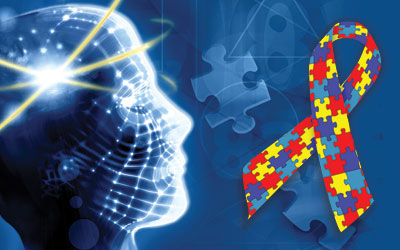Autism: Making Progress
By Shilo Rea / 412-268-6094 / shilo@cmu.edu / and Jocelyn Duffy / 412-268-9982 / jhduffy@andrew.cmu.edu
According to a 2014 Centers for Disease Control and Prevention report, autism — a complex developmental disorder — will affect one out of every 68 children born in the United States. The lifetime cost to care for a child with autism is estimated to be as great as $2.4 million.
 But, while no single cause or cure has yet to be found, there is optimism as researchers — including several at Carnegie Mellon University — are making significant progress with groundbreaking discoveries that are being highlighted this April during National Autism Awareness Month.
But, while no single cause or cure has yet to be found, there is optimism as researchers — including several at Carnegie Mellon University — are making significant progress with groundbreaking discoveries that are being highlighted this April during National Autism Awareness Month.
Marcel Just, the D.O. Hebb University Professor of Psychology in the Dietrich College of Humanities and Social Sciences, has been studying the disorder for 18 years. Just uses brain imaging to understand how brain processes support various kinds of human thought, specifically in autism.
With his influential Frontal-Posterior Underconnectivity Theory of Autism, published in 2004, Just was the first to discover and explain that the synchronization of the activation between frontal and posterior brain areas is lower in autism. Since then, he has expanded that theory to include how the brain's white matter tracts — the cabling that connects separated brain areas — are altered in autism and how these alterations can affect brain function and behavior.
Most recently, Just created brain-reading techniques to use neural representations of social thoughts (such as hugging or praising) to predict autism diagnoses with 97 percent accuracy. This established the first biologically based diagnostic tool that measures a person's thoughts to detect the disorder.
“Our understanding of the biological basis of autism has grown at a remarkable pace over the past 20 years, and the light at the end of the tunnel is coming into view,” Just said.
Marlene Behrmann also uses the most advanced brain imaging technology available to understand the differences between the brains of people with autism and those without.
Behrmann, the CMU co-director of the Center for the Neural Basis of Cognition (CNBC) and the George A. and Helen Dunham Cowan Professor of Cognitive Neuroscience, discovered “idiosyncratic” brain patterns in autism, something that could impact earlier diagnosis of the disorder and future treatments.
"Identifying brain profiles that differ from the pattern observed in typically developing individuals is crucial not only in that it allows researchers to begin to understand the differences that arise in autism but, in this case, it opens up the possibility that there are many altered brain profiles all of which fall under the umbrella of 'autism' or 'autisms,'" she said.
In line with Behrmann’s work, Nathan Urban is using a grant from the Simons Foundation Autism Research Initiative to study the responses of neurons in models of autism that have been engineered to have some of the same genetic mutations known to occur in some individuals with autism.
Using three different genetic models, Urban, CMU’s interim provost and the Dr. Frederick A. Schwertz Distinguished Professor of Life Sciences in the Mellon College of Science, is determining whether alterations in single neurons, synapses or neuronal circuits contribute to changes in the reliability of sensory-evoked neuronal responses.
The combination of Just, Behrmann and Urban’s work is one example of how Carnegie Mellon’s BrainHubSM initiative uses biology, computer science, psychology, statistics and engineering to figure out how the structure and activity of the brain give rise to complex behaviors.
Beyond brain research and the neurological causes of autism, CMU’s Kathryn Roeder focuses on its genetic composition. Roeder, professor of statistics and computational biology, develops new statistical methods — such as machine learning techniques and dimension reduction tools — to allow researchers to reliably determine how the disorder is inherited.
Last summer, she led an international research team to discover that most of the genetic risk for autism comes from versions of genes that are common in the population, rather than from rare variants or spontaneous glitches.
"From this study, we can see that genetics plays a major role in the development of autism compared to environmental risk factors, making autism more like height than we thought — many small risk factors add up, each pushing a person further out on the spectrum," Roeder said.
"These findings could not have happened without statistics, and now we must build off of what we learned and use statistical approaches to determine where to put future resources, and decide what is the most beneficial direction to pursue to further pinpoint what causes autism,” she said.
Carnegie Mellon researchers are committed to learning more about the disorder and how it can be most effectively diagnosed and treated.
Related Links:
Autism Society http://www.autism-society.org/
BrainHub http://www.cmu.edu/research/brain/
Dietrich College http://www.cmu.edu/dietrich/
Mellon College of Science http://www.cmu.edu/mcs/
Center for Cognitive Brain Imaging http://www.ccbi.cmu.edu/
Scientific Imaging and Brain Research Center http://www.sibr.cmu.edu/